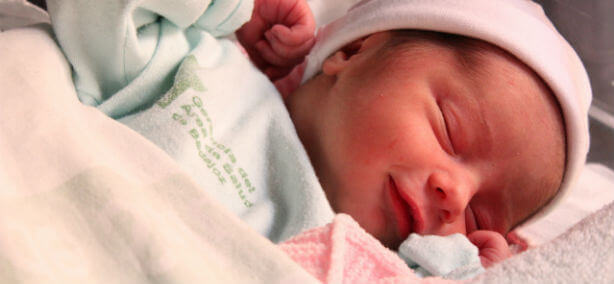13 Curious Facts About Newborns

In this article, we’ll look at some curious facts about newborns and dispel a few child development myths. When you finish reading, you will be even more fascinated with your baby than you were before.
When you start down the path of motherhood for the first time, you discover a whole universe of new experiences, each one of which you’ll learn to enjoy along the way.
If you’re already a mother with more than one child, then you’ll know that each one develops and behaves very differently.
A baby is something you carry inside you for nine months, in your arms for three years and in your heart till the day you die.
-Mary Mason-
The most curious facts about newborns
1. Formation of cartilage
When they are born, children have cartilage which will later develop into their kneecaps. This firm, flexible connective tissue is very important when the child learns to move around, at around 6 months of age.
2. High-contrast vision
Newborns can only focus their sight at a distance of around 8 to 10 inches from their face. The images they can see best are those in high-contrast black and white. Their eye cells are not yet capable of distinguishing colors.
3. Birth weight
Male babies normally weigh more than girls at birth. The average birth weight of a boy is between 5 lb 8 oz and 9 lb 7 oz. Baby girls, meanwhile, should weigh between 5 lb 4 oz and 9 lb 4 oz at birth.

4. Number of bones
When babies are born, their skeleton is not yet fully developed. At birth, babies have 300 bones. Over time, some of these bones will fuse to form more complex structures. By adulthood, we have 206 bones in our bodies.
5. Sense of taste
A newborn baby has over 10,000 tastebuds on their tongue. This is much more than adults. The additional tastebuds will normally disappear by the time they reach adulthood.
6. Sleep routines
In total, a newborn baby should sleep for around 15 to 17 hours a day. Unlike adults, however, babies sleep for short periods. Naps will last around 2 to 4 hours during your baby’s first few weeks of life. Later on, their sleep patterns will gradually begin to stabilize.
7. Heartbeat
Another one of the interesting facts about newborns that parents learn is that their heartbeat is much faster than you might think. A baby’s heart beats 130 to 160 times a minute.
That is almost twice as fast as the heartbeat of a normal adult.
8. Sense of hearing
Babies are born with a fairly well developed sense of hearing. They are immediately able to identify where a sound or voice comes from. This ability is active in their brains from the first 10 minutes of life.
9. Breathing and swallowing
Unlike an adult, there are two very important actions that babies are able to do at the same time, which help them to feed: breathing and swallowing. This ability disappears at around 7 months of age, however.
10. Hair color and texture
The hair your baby is born with may be different in color and texture to the hair they will have later in life. Hair can fall out during the first few weeks of a baby’s life, and will grow back during their first year. The color, thickness and texture of this hair can vary.

11. Reflexes
Reflexes are automatic responses of the body to external stimuli. Newborn babies have many of them. A baby is born with a set of about 70 primitive reflexes, which will go away as they grow older.
12. Exploring the world
Little ones explore their surroundings using their sense of touch. The most sensitive part of their body is their mouth. This is why they tend to put things in it.
13. Eye Color
Many babies are born with blue eyes which change color later. This is due to the fact that melanin, the pigment which gives us our eye color, has not yet developed. A child’s final eye color will appear at around 6 months of age.
These are just a few of the many curious facts about newborns. Enjoy this phase of your child’s development and be sure not to miss these fascinating little details.
In this article, we’ll look at some curious facts about newborns and dispel a few child development myths. When you finish reading, you will be even more fascinated with your baby than you were before.
When you start down the path of motherhood for the first time, you discover a whole universe of new experiences, each one of which you’ll learn to enjoy along the way.
If you’re already a mother with more than one child, then you’ll know that each one develops and behaves very differently.
A baby is something you carry inside you for nine months, in your arms for three years and in your heart till the day you die.
-Mary Mason-
The most curious facts about newborns
1. Formation of cartilage
When they are born, children have cartilage which will later develop into their kneecaps. This firm, flexible connective tissue is very important when the child learns to move around, at around 6 months of age.
2. High-contrast vision
Newborns can only focus their sight at a distance of around 8 to 10 inches from their face. The images they can see best are those in high-contrast black and white. Their eye cells are not yet capable of distinguishing colors.
3. Birth weight
Male babies normally weigh more than girls at birth. The average birth weight of a boy is between 5 lb 8 oz and 9 lb 7 oz. Baby girls, meanwhile, should weigh between 5 lb 4 oz and 9 lb 4 oz at birth.

4. Number of bones
When babies are born, their skeleton is not yet fully developed. At birth, babies have 300 bones. Over time, some of these bones will fuse to form more complex structures. By adulthood, we have 206 bones in our bodies.
5. Sense of taste
A newborn baby has over 10,000 tastebuds on their tongue. This is much more than adults. The additional tastebuds will normally disappear by the time they reach adulthood.
6. Sleep routines
In total, a newborn baby should sleep for around 15 to 17 hours a day. Unlike adults, however, babies sleep for short periods. Naps will last around 2 to 4 hours during your baby’s first few weeks of life. Later on, their sleep patterns will gradually begin to stabilize.
7. Heartbeat
Another one of the interesting facts about newborns that parents learn is that their heartbeat is much faster than you might think. A baby’s heart beats 130 to 160 times a minute.
That is almost twice as fast as the heartbeat of a normal adult.
8. Sense of hearing
Babies are born with a fairly well developed sense of hearing. They are immediately able to identify where a sound or voice comes from. This ability is active in their brains from the first 10 minutes of life.
9. Breathing and swallowing
Unlike an adult, there are two very important actions that babies are able to do at the same time, which help them to feed: breathing and swallowing. This ability disappears at around 7 months of age, however.
10. Hair color and texture
The hair your baby is born with may be different in color and texture to the hair they will have later in life. Hair can fall out during the first few weeks of a baby’s life, and will grow back during their first year. The color, thickness and texture of this hair can vary.

11. Reflexes
Reflexes are automatic responses of the body to external stimuli. Newborn babies have many of them. A baby is born with a set of about 70 primitive reflexes, which will go away as they grow older.
12. Exploring the world
Little ones explore their surroundings using their sense of touch. The most sensitive part of their body is their mouth. This is why they tend to put things in it.
13. Eye Color
Many babies are born with blue eyes which change color later. This is due to the fact that melanin, the pigment which gives us our eye color, has not yet developed. A child’s final eye color will appear at around 6 months of age.
These are just a few of the many curious facts about newborns. Enjoy this phase of your child’s development and be sure not to miss these fascinating little details.
This text is provided for informational purposes only and does not replace consultation with a professional. If in doubt, consult your specialist.








